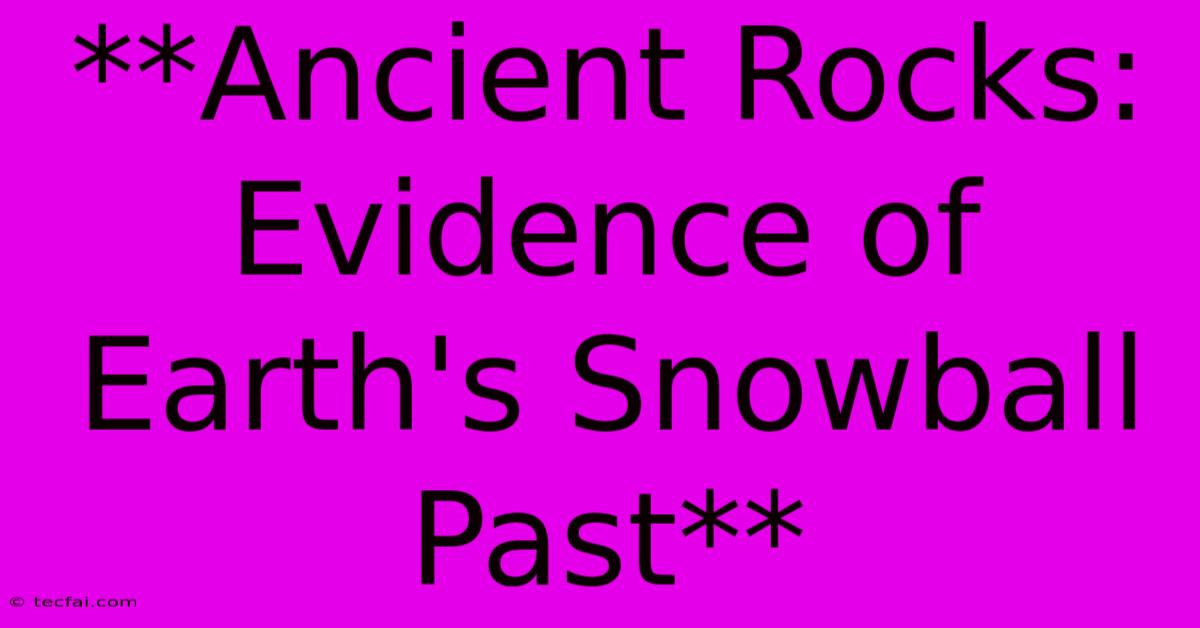**Ancient Rocks: Evidence Of Earth's Snowball Past**

Discover more detailed and exciting information on our website. Click the link below to start your adventure: Visit Best Website tecfai.com. Don't miss out!
Table of Contents
Ancient Rocks: Evidence of Earth's Snowball Past
The Earth we know and love, teeming with life and diverse ecosystems, wasn't always so vibrant. Billions of years ago, our planet underwent periods of extreme cold, where vast glaciers covered the continents and the oceans froze solid. This "Snowball Earth" hypothesis, a topic of intense scientific debate, proposes that our planet was essentially a giant, icy ball. While seemingly unbelievable, evidence for these ancient ice ages lies embedded in rocks across the globe.
Uncovering the Frozen Past: What do Rocks Tell Us?
Sedimentary rocks, formed from the accumulation and compression of sediment over millions of years, are key to understanding Earth's history. In particular, glacial deposits – layers of rock and sediment transported and deposited by glaciers – provide compelling evidence for Snowball Earth events. These deposits often exhibit distinctive features:
- Dropstones: Large, angular boulders dropped from melting glaciers, found within fine-grained sediments like mudstone or sandstone.
- Tillite: A hardened form of glacial till, a mixture of rocks, sand, and clay deposited by glaciers, often containing striations – grooves and scratches created by rocks dragged along the glacier's base.
- Varves: Alternating layers of light-colored, coarser sediment and dark-colored, finer sediment deposited annually in glacial lakes, providing a record of seasonal variations.
The Case for a Global Freeze: Clues from Isotopes
Beyond glacial deposits, isotopic analysis of ancient rocks provides additional support for the Snowball Earth hypothesis. Isotopes are atoms of the same element with different numbers of neutrons, and their ratios in rocks can reveal details about past climate conditions.
- Carbon isotopes: The ratio of carbon-13 to carbon-12 in ancient rocks suggests a period of reduced carbon dioxide levels, likely caused by the widespread formation of glaciers.
- Oxygen isotopes: Analysis of oxygen isotopes in ancient rocks suggests a significant expansion of glaciers, as the heavy oxygen isotope (O-18) becomes concentrated in the remaining unfrozen water.
Why Did the Earth Freeze?
While scientists still debate the precise causes of Snowball Earth events, several factors are believed to have played a role:
- Continental Drift: The arrangement of continents can influence global climate patterns, leading to periods of intense cooling.
- Volcanic Activity: Volcanic eruptions can release large amounts of greenhouse gases, which trap heat in the atmosphere. However, decreased volcanic activity could lead to a cooling effect.
- Solar Output: Changes in the sun's energy output, albeit small, can have significant effects on Earth's climate over long periods.
The Aftermath: Thawing out of a Frozen World
The Snowball Earth hypothesis suggests that these periods of global glaciation were not permanent. Eventually, volcanic eruptions released enough greenhouse gases into the atmosphere to warm the planet, causing the ice to melt. This melting process likely led to intense weathering and erosion, resulting in massive deposits of sediment.
A Window into Earth's Past: Implications for the Future
Understanding the Snowball Earth hypothesis is critical for comprehending the Earth's dynamic climate system. Studying ancient rocks provides insights into how the Earth has responded to changes in atmospheric composition, solar radiation, and continental drift. These insights can help us better understand the current climate crisis and predict potential future climate changes.
As scientists continue to explore the ancient rocks and their secrets, we gain a deeper appreciation for the resilience of our planet and the intricate interplay of geological and climate forces that shape our world. The story of Earth's Snowball past serves as a powerful reminder of the profound and enduring nature of change, and the need to understand and address the challenges we face in the present.

Thank you for visiting our website wich cover about **Ancient Rocks: Evidence Of Earth's Snowball Past**. We hope the information provided has been useful to you. Feel free to contact us if you have any questions or need further assistance. See you next time and dont miss to bookmark.
Featured Posts
-
Trump Picks Gaetz As Attorney General
Nov 14, 2024
-
Ionic Rare Earths Strategic Exploration Advancements
Nov 14, 2024
-
Gaetz To Be Attorney General Trump Announcement
Nov 14, 2024
-
Whoopi Goldbergs Tv Network Dedicated To Topic
Nov 14, 2024
-
Coldplay Pays Tribute To Travis Scott
Nov 14, 2024
